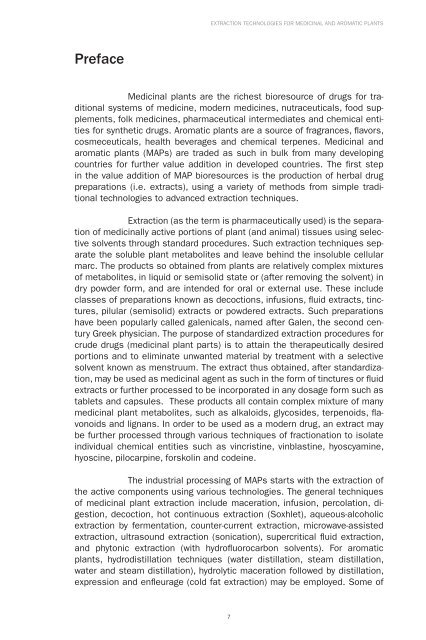Extraction Technologies For Medicinal And Aromatic Plants - Unido
Extraction Technologies For Medicinal And Aromatic Plants - Unido
Extraction Technologies For Medicinal And Aromatic Plants - Unido
Create successful ePaper yourself
Turn your PDF publications into a flip-book with our unique Google optimized e-Paper software.
Preface<br />
EXTRACTION TECHNOLOGIES FOR MEDICINAL AND AROMATIC PLANTS<br />
<strong>Medicinal</strong> plants are the richest bioresource of drugs for traditional<br />
systems of medicine, modern medicines, nutraceuticals, food supplements,<br />
folk medicines, pharmaceutical intermediates and chemical entities<br />
for synthetic drugs. <strong>Aromatic</strong> plants are a source of fragrances, fl avors,<br />
cosmeceuticals, health beverages and chemical terpenes. <strong>Medicinal</strong> and<br />
aromatic plants (MAPs) are traded as such in bulk from many developing<br />
countries for further value addition in developed countries. The fi rst step<br />
in the value addition of MAP bioresources is the production of herbal drug<br />
preparations (i.e. extracts), using a variety of methods from simple traditional<br />
technologies to advanced extraction techniques.<br />
<strong>Extraction</strong> (as the term is pharmaceutically used) is the separation<br />
of medicinally active portions of plant (and animal) tissues using selective<br />
solvents through standard procedures. Such extraction techniques separate<br />
the soluble plant metabolites and leave behind the insoluble cellular<br />
marc. The products so obtained from plants are relatively complex mixtures<br />
of metabolites, in liquid or semisolid state or (after removing the solvent) in<br />
dry powder form, and are intended for oral or external use. These include<br />
classes of preparations known as decoctions, infusions, fl uid extracts, tinctures,<br />
pilular (semisolid) extracts or powdered extracts. Such preparations<br />
have been popularly called galenicals, named after Galen, the second century<br />
Greek physician. The purpose of standardized extraction procedures for<br />
crude drugs (medicinal plant parts) is to attain the therapeutically desired<br />
portions and to eliminate unwanted material by treatment with a selective<br />
solvent known as menstruum. The extract thus obtained, after standardization,<br />
may be used as medicinal agent as such in the form of tinctures or fl uid<br />
extracts or further processed to be incorporated in any dosage form such as<br />
tablets and capsules. These products all contain complex mixture of many<br />
medicinal plant metabolites, such as alkaloids, glycosides, terpenoids, fl avonoids<br />
and lignans. In order to be used as a modern drug, an extract may<br />
be further processed through various techniques of fractionation to isolate<br />
individual chemical entities such as vincristine, vinblastine, hyoscyamine,<br />
hyoscine, pilocarpine, forskolin and codeine.<br />
The industrial processing of MAPs starts with the extraction of<br />
the active components using various technologies. The general techniques<br />
of medicinal plant extraction include maceration, infusion, percolation, digestion,<br />
decoction, hot continuous extraction (Soxhlet), aqueous-alcoholic<br />
extraction by fermentation, counter-current extraction, microwave-assisted<br />
extraction, ultrasound extraction (sonication), supercritical fl uid extraction,<br />
and phytonic extraction (with hydrofl uorocarbon solvents). <strong>For</strong> aromatic<br />
plants, hydrodistillation techniques (water distillation, steam distillation,<br />
water and steam distillation), hydrolytic maceration followed by distillation,<br />
expression and enfl eurage (cold fat extraction) may be employed. Some of<br />
7

















